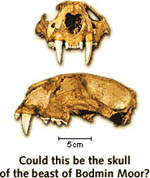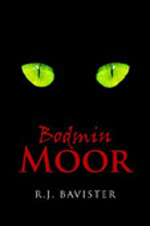
The Beast of Bodmin Moor is a reported large feline like creature thought to stalk the area in and around Bodmin Moor located in Cornwell of southwestern England. The investigation of what have become known as Alien Big Cats, or ABCs, has increased in popularity in recent years to become one of the most popular subcategories of cryptozoology in England. The term Alien is used here not to describe something as extraterrestrial but more of an animal existing in an area that modern zoology says it should not. An example of this would be the Beast of Bodmin Moor, which is reportedly a large feline like creature, possibly a leopard, existing in Europe, a place that modern zoology states does not have a population of any large cats.  In the early 1990’s reports started to circulate of an Alien Big Cat, or possibly a group of them, living in and around Cornwall, England, primarily in a southwestern region known as Bodmin Moor, where a large number of livestock were found slain, presumably by a leopard like feline. Talk of dangerous wild cats led Great Britain’s Ministry of Agriculture, Fisheries and Food to conduct an official investigation into the phenomena in 1995. The investigation released its findings on July 19th of that same year and concluded that there was no verifiable evidence of Alien Big Cats existing in England and that the mauled farm animals could have been attacked by an indigenous species. However that same report also conceded that the investigation could not prove that an Alien Big Cat was not present in England.
In the early 1990’s reports started to circulate of an Alien Big Cat, or possibly a group of them, living in and around Cornwall, England, primarily in a southwestern region known as Bodmin Moor, where a large number of livestock were found slain, presumably by a leopard like feline. Talk of dangerous wild cats led Great Britain’s Ministry of Agriculture, Fisheries and Food to conduct an official investigation into the phenomena in 1995. The investigation released its findings on July 19th of that same year and concluded that there was no verifiable evidence of Alien Big Cats existing in England and that the mauled farm animals could have been attacked by an indigenous species. However that same report also conceded that the investigation could not prove that an Alien Big Cat was not present in England.  On July 24th, less than a week after the Ministry released its report on Alien Big Cats, a 14 year old boy named Barney Lanyon Jones was walking with his brothers on the banks of the Fowey River near the southern edge of Bodmin Moor when he saw a out of place object floating in the river. Barney thought the object was an oddly shaped rock until he pulled it out of the water and discovered that it was not a rock but the skull of a large cat. The skull, though missing the lower jaw, measured about 4 inches wide and 7 inches long, it possessed two sharp prominent teeth that suggested the skull had come from a leopard. On July 31st the story of this skull hit the national press which presented a well timed rebuttal to the official denial of Alien Big Cat evidence in Bodmin Moor by the government’s investigation.
On July 24th, less than a week after the Ministry released its report on Alien Big Cats, a 14 year old boy named Barney Lanyon Jones was walking with his brothers on the banks of the Fowey River near the southern edge of Bodmin Moor when he saw a out of place object floating in the river. Barney thought the object was an oddly shaped rock until he pulled it out of the water and discovered that it was not a rock but the skull of a large cat. The skull, though missing the lower jaw, measured about 4 inches wide and 7 inches long, it possessed two sharp prominent teeth that suggested the skull had come from a leopard. On July 31st the story of this skull hit the national press which presented a well timed rebuttal to the official denial of Alien Big Cat evidence in Bodmin Moor by the government’s investigation.
The skull was turned over to London’s British Museum of Natural History by the Lanyon Jones family to verify its authenticity. It was then examined by the museum’s assistant keeper of zoology, Doctor Ian Bishop; who determined that the skull was genuine and belonged to a young male leopard. Further investigation led Doctor Bishop to conclude that the leopard did not die in England, but instead had been imported as part of a leopard skin rug. He noted that the back of the skull had been cleanly cut off in a way that is commonly used to mount a head on a rug, he also found the egg case of a tropical cockroach, not found in England’s climate, inside of the skull. In addition he found fine cut marks on the skull indicating that the skin of the leopard had been removed with a knife.  Sightings of the Beast of Bodmin Moor continue to this day including more than 300 in 1996 alone. In October of 1997, officials from Newquay Zoo claimed to have identified paw prints discovered in mud to the south of Bodmin Moor as the fresh tracks of a puma. Shortly after the discovery of these prints a photograph, allegedly of the Beast of Bodmin Moor, was brought to light, the image in the photo appeared to be an apparently pregnant, adult female puma. This photograph caused much debate in the scientific community and added fuel to the debate of the existence of Alien Big Cats living in England, these photos were never authenticated or conclusively debunked and remains a controversial piece of evidence to his day.
Sightings of the Beast of Bodmin Moor continue to this day including more than 300 in 1996 alone. In October of 1997, officials from Newquay Zoo claimed to have identified paw prints discovered in mud to the south of Bodmin Moor as the fresh tracks of a puma. Shortly after the discovery of these prints a photograph, allegedly of the Beast of Bodmin Moor, was brought to light, the image in the photo appeared to be an apparently pregnant, adult female puma. This photograph caused much debate in the scientific community and added fuel to the debate of the existence of Alien Big Cats living in England, these photos were never authenticated or conclusively debunked and remains a controversial piece of evidence to his day.
The Evidence
Paw prints found near Bodmin Moor were studied by officials from the Newquay Zoo and determined to be those of a puma, giving some credibility to the existence of these large cats in England.
The Sightings
Though descriptions of several sightings could be found, no sightings documenting names or dates could be located at this time.
The Stats – (Where applicable)
• Classification: Hybrid / Other
• Size: Unknown
• Weight: Unknown
• Diet: Carnivorous
• Location: England
• Movement: Four Legged Walking
• Environment: Forests and fields
|